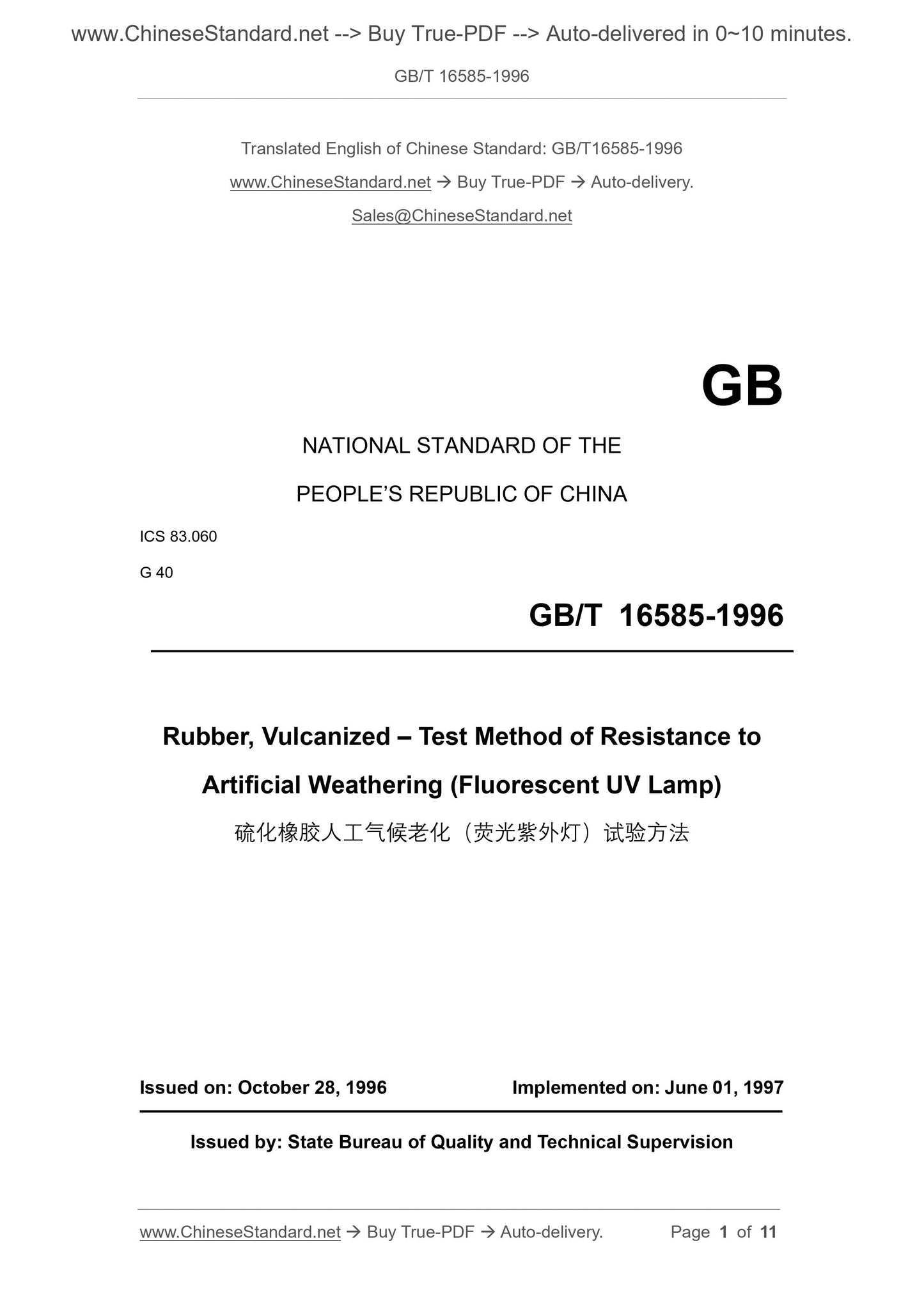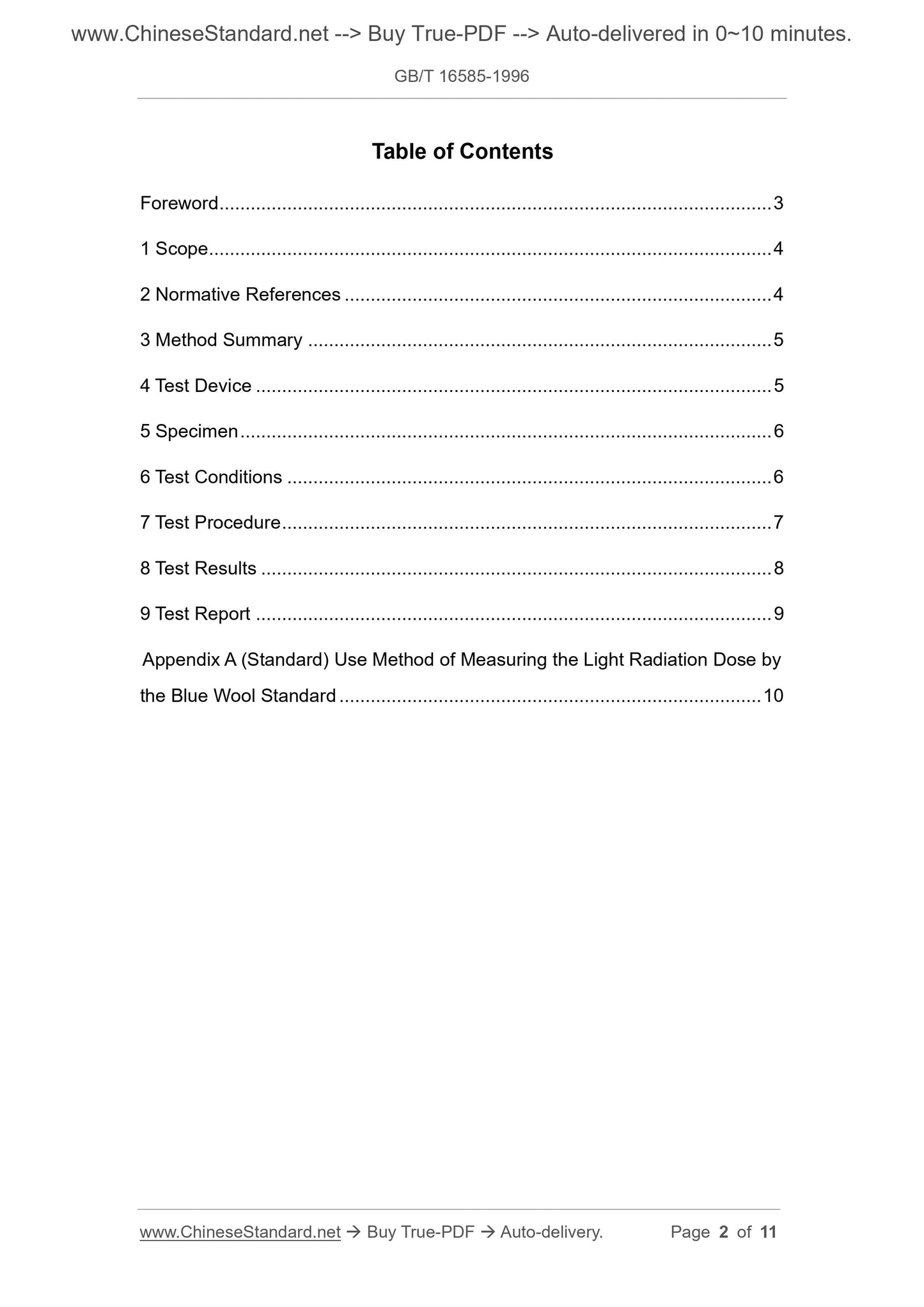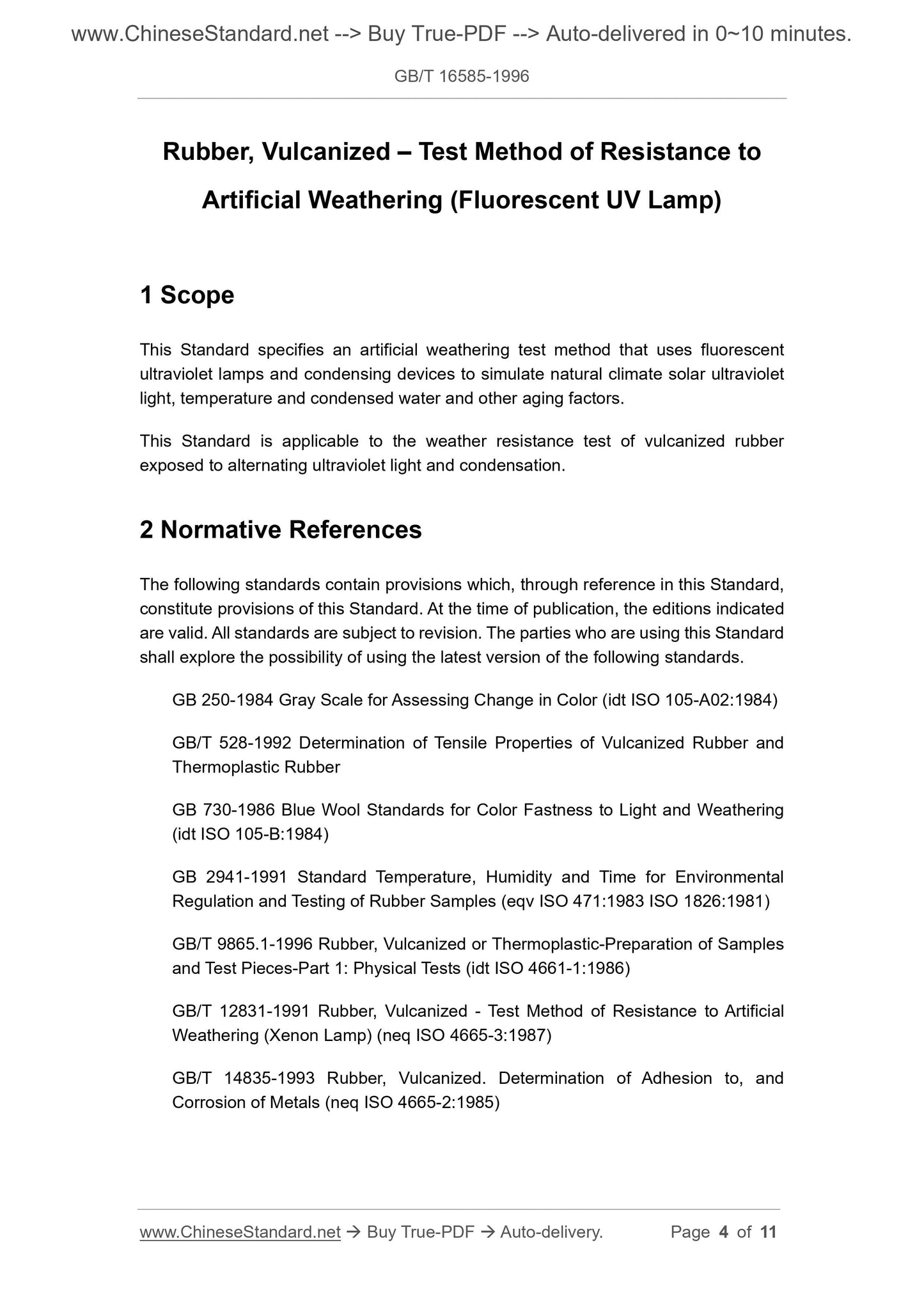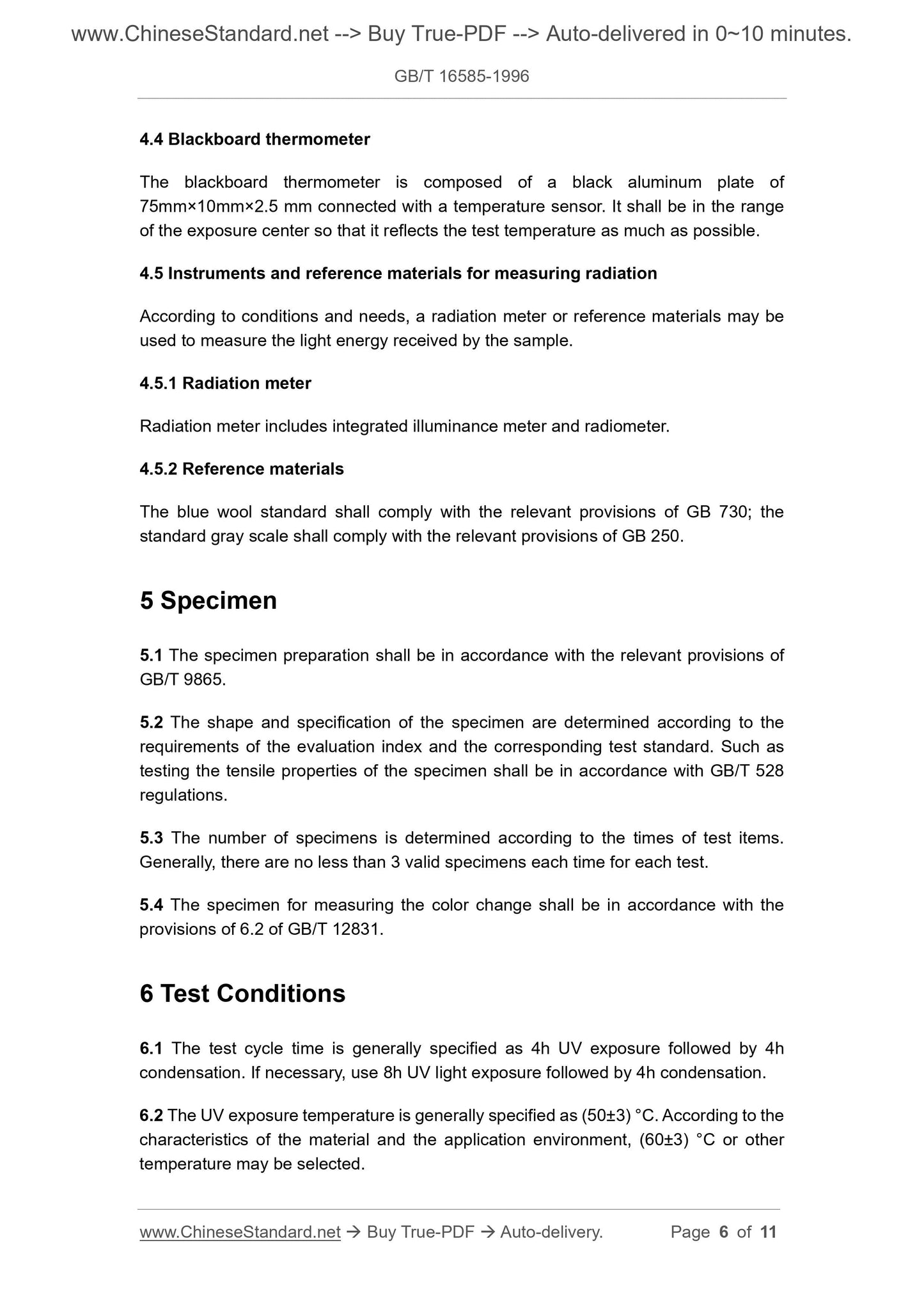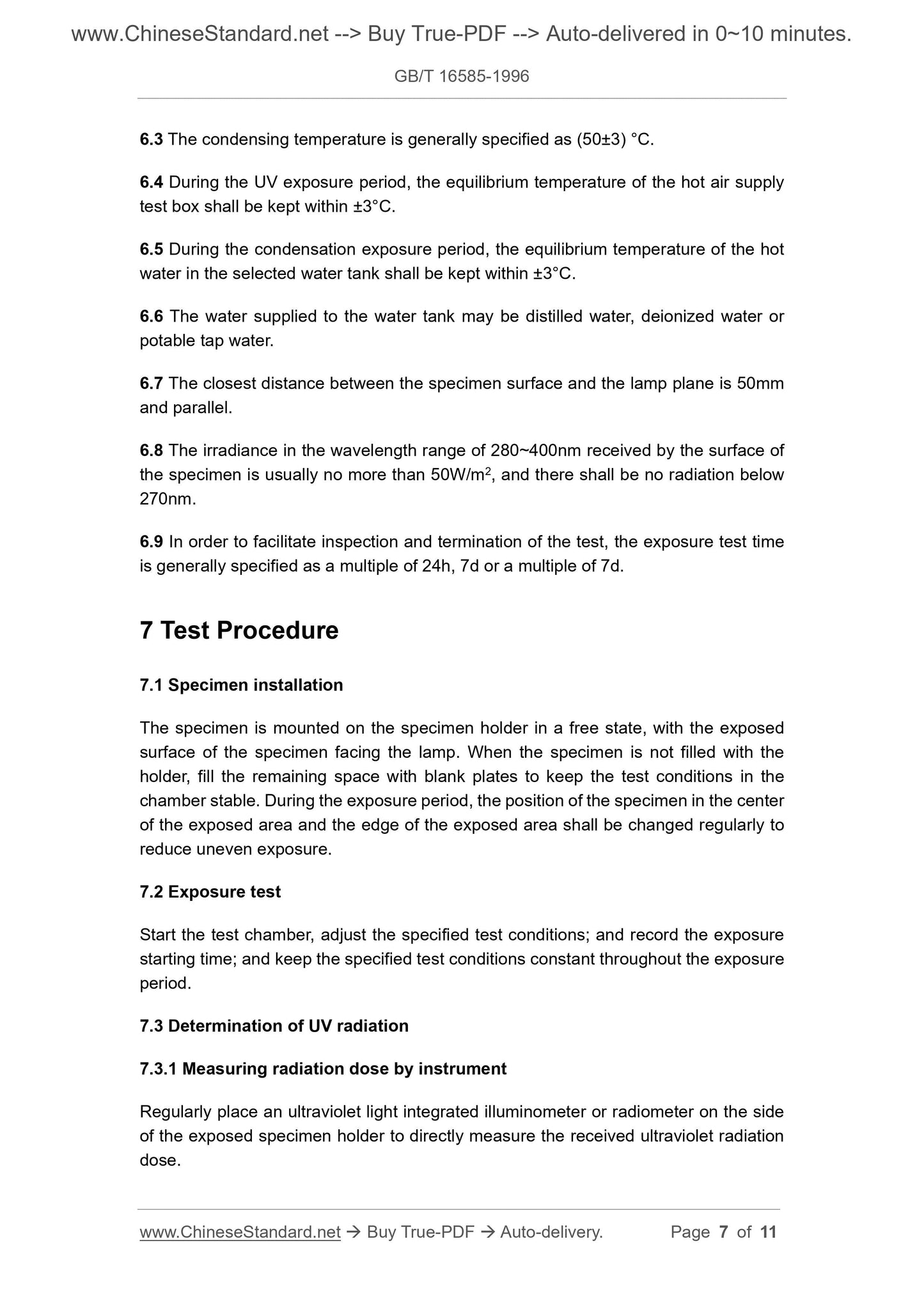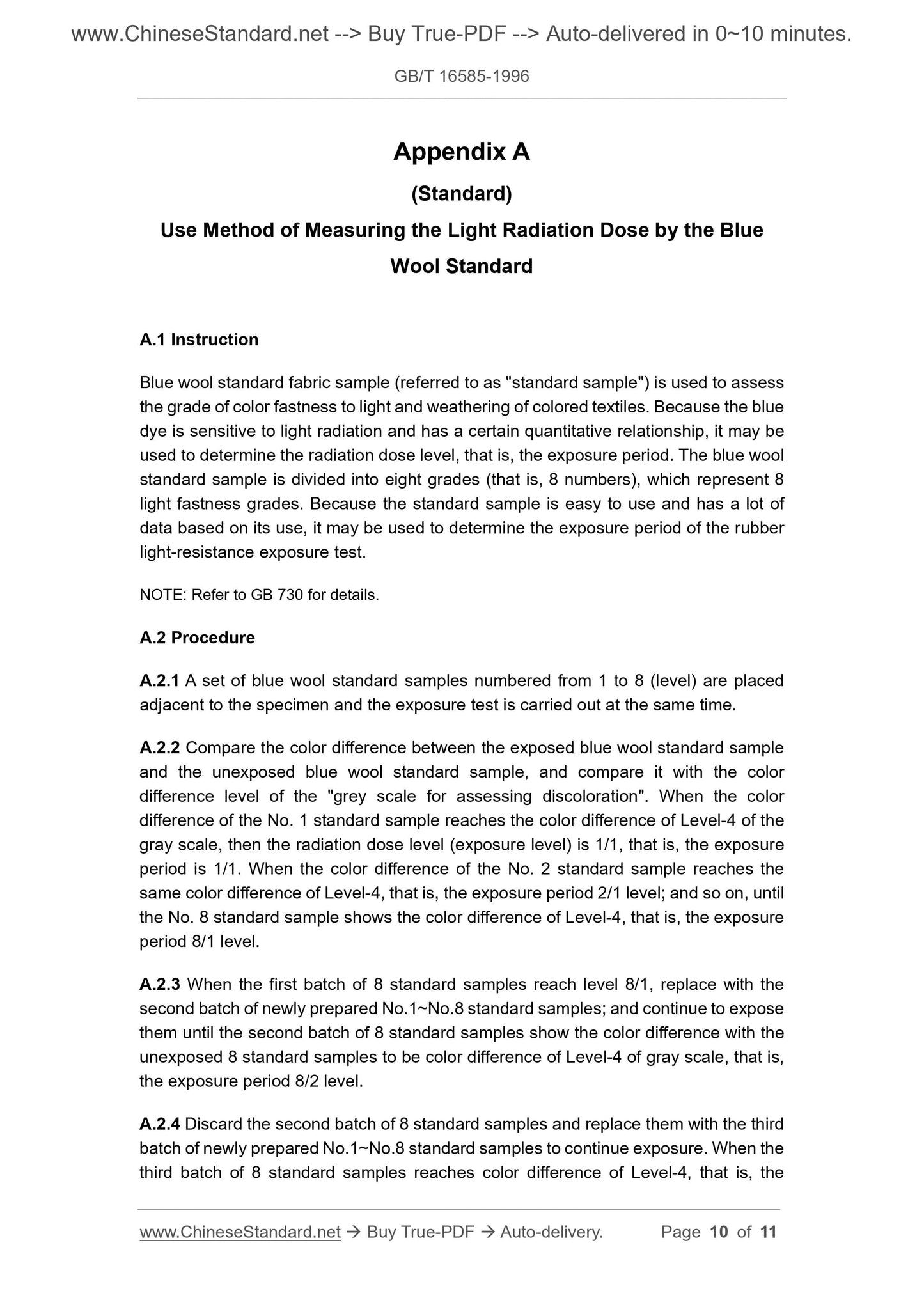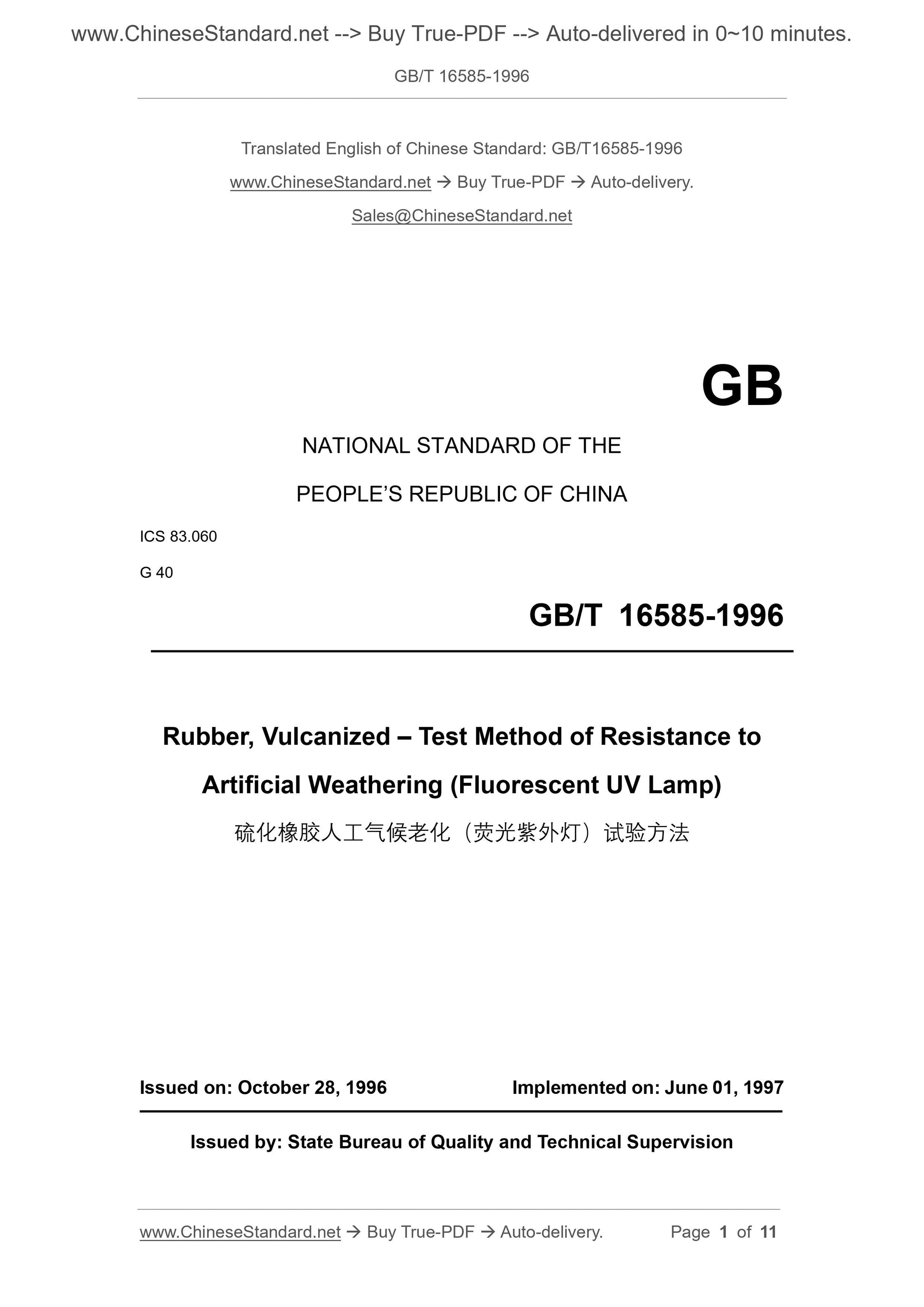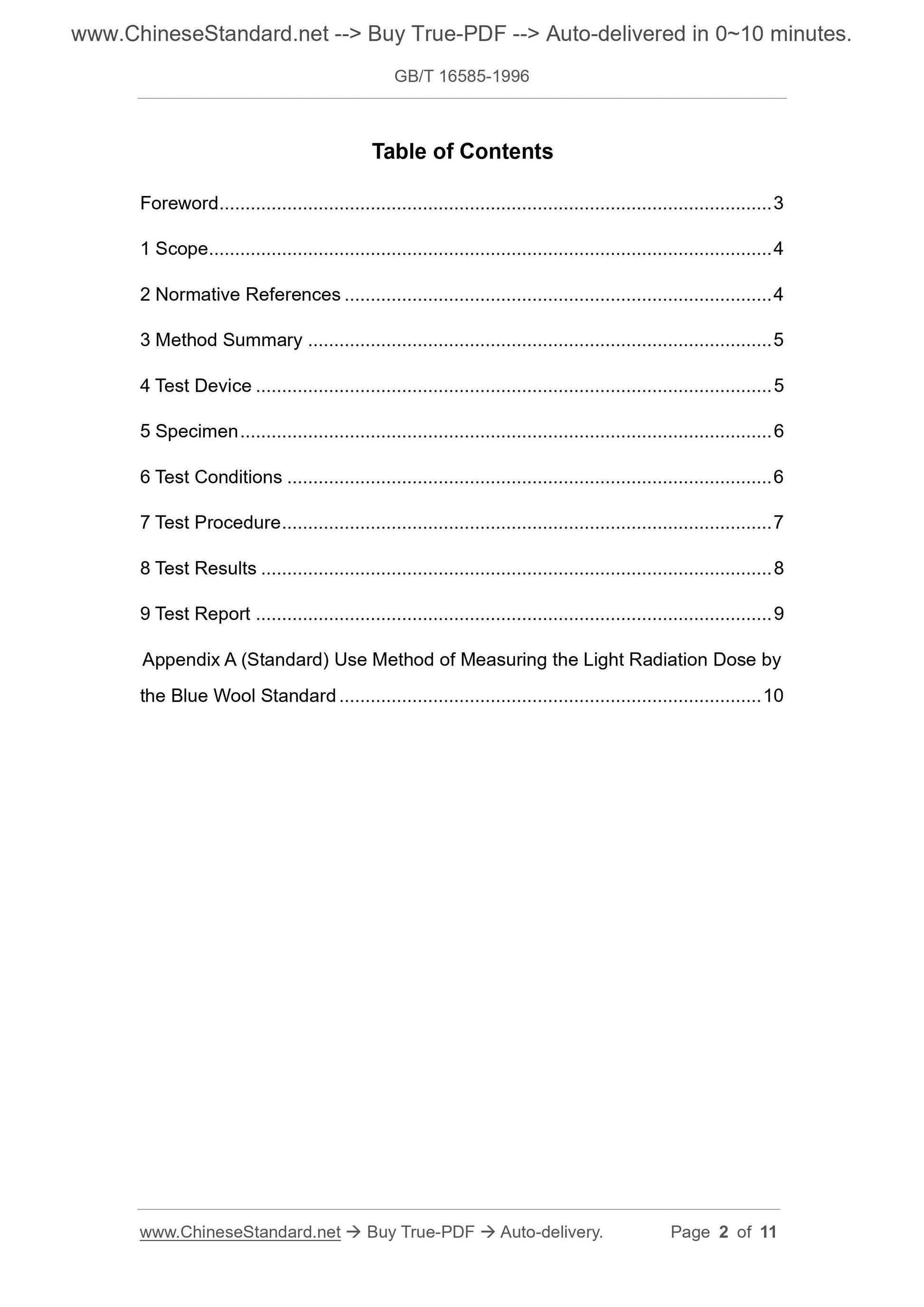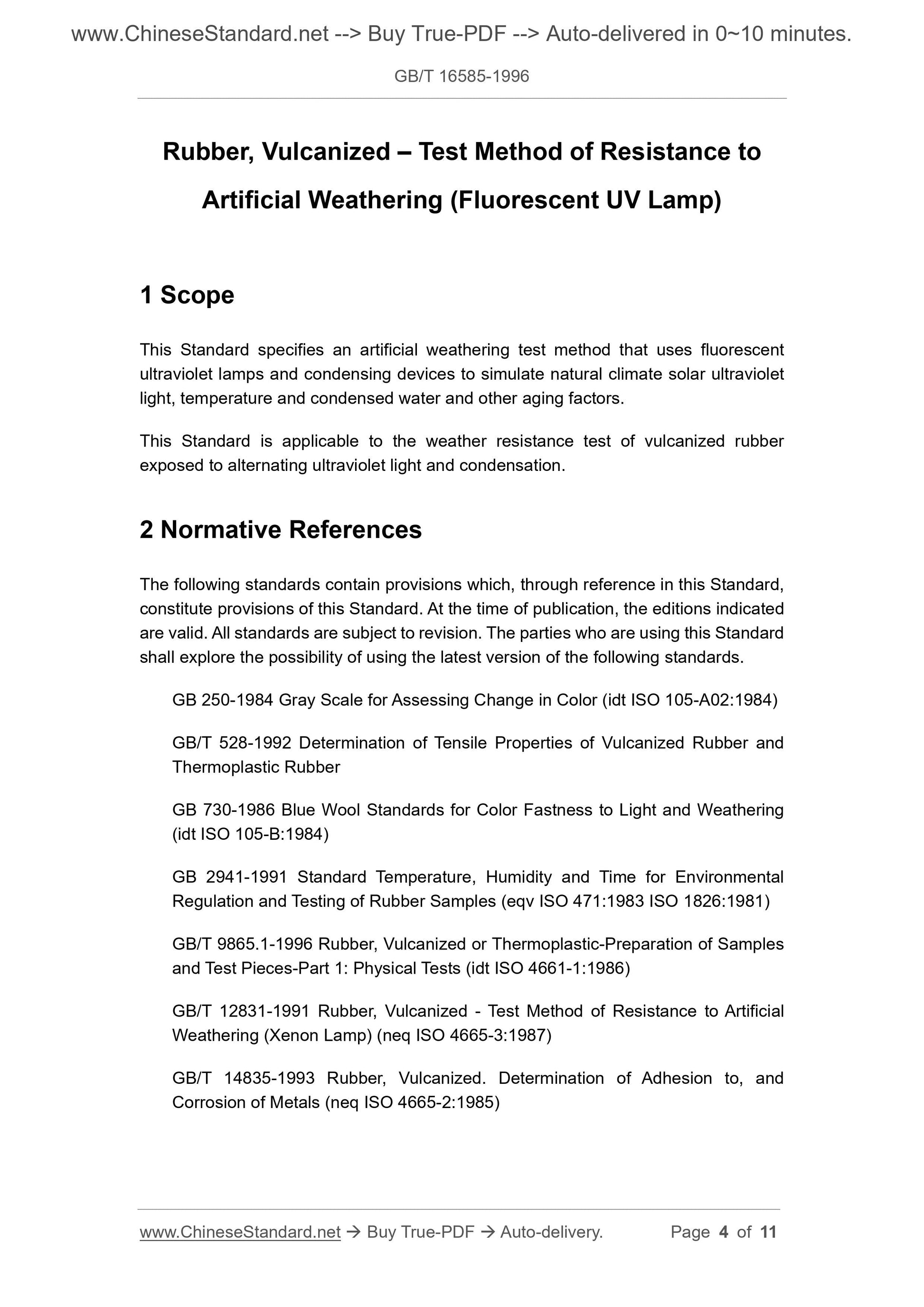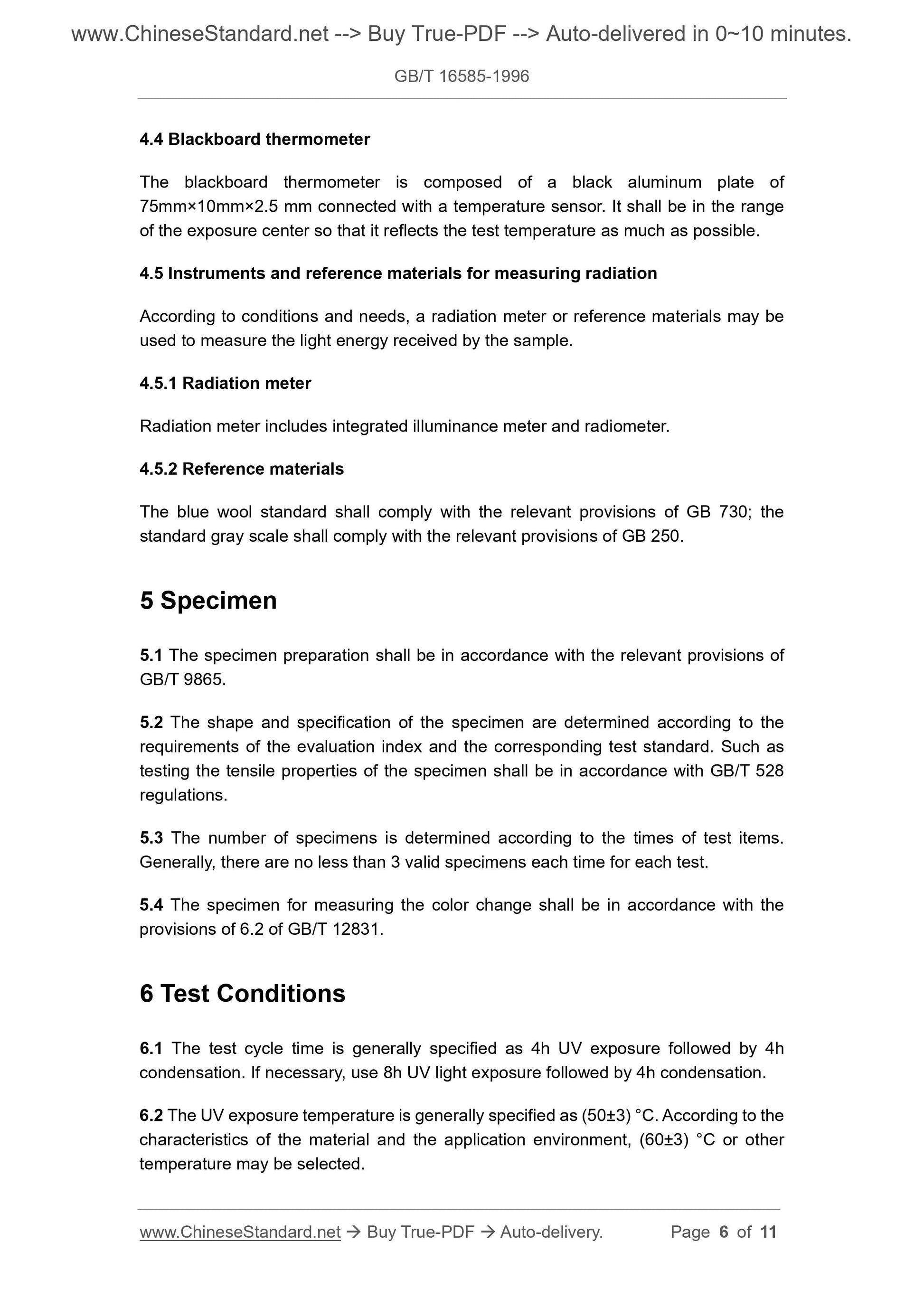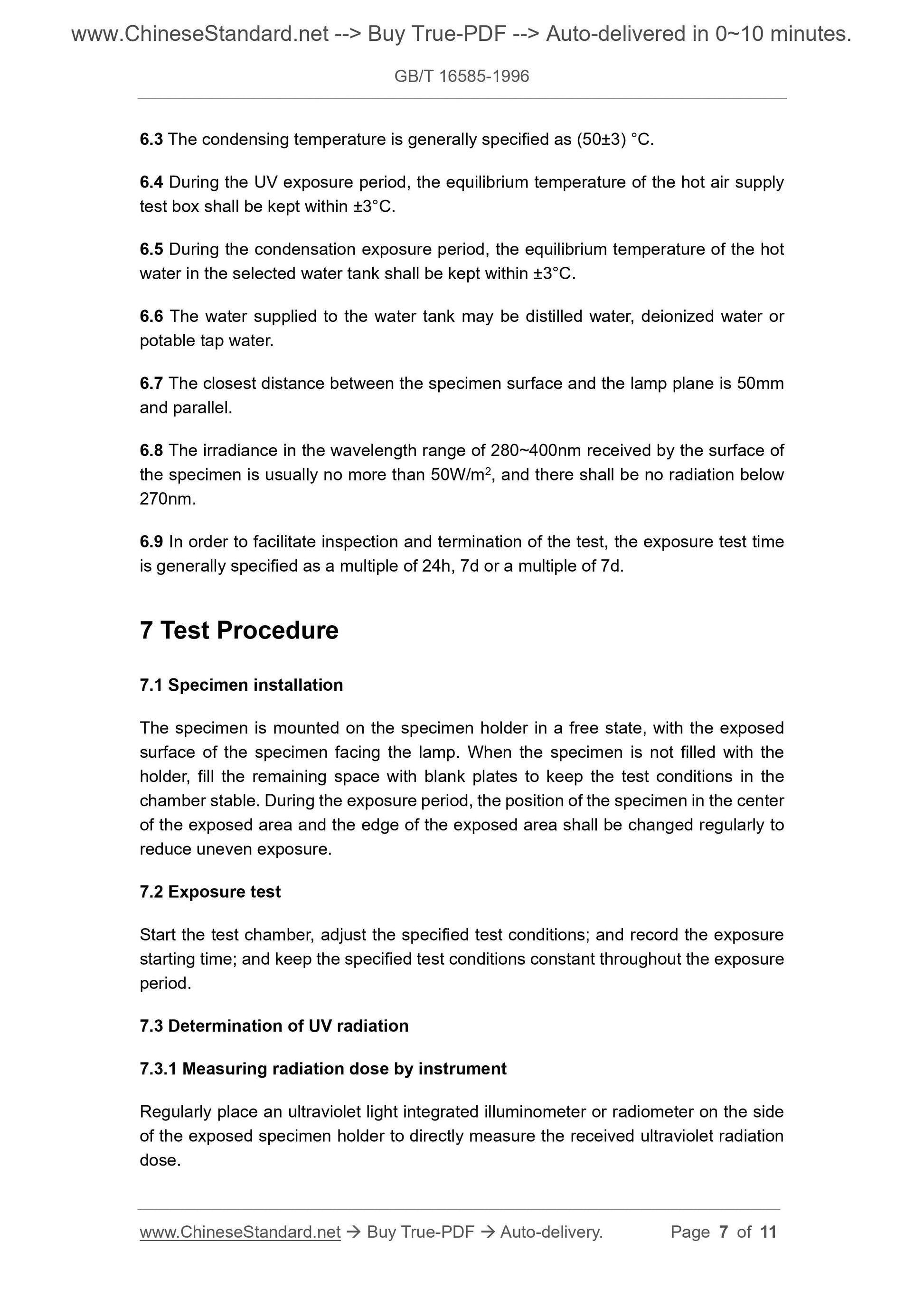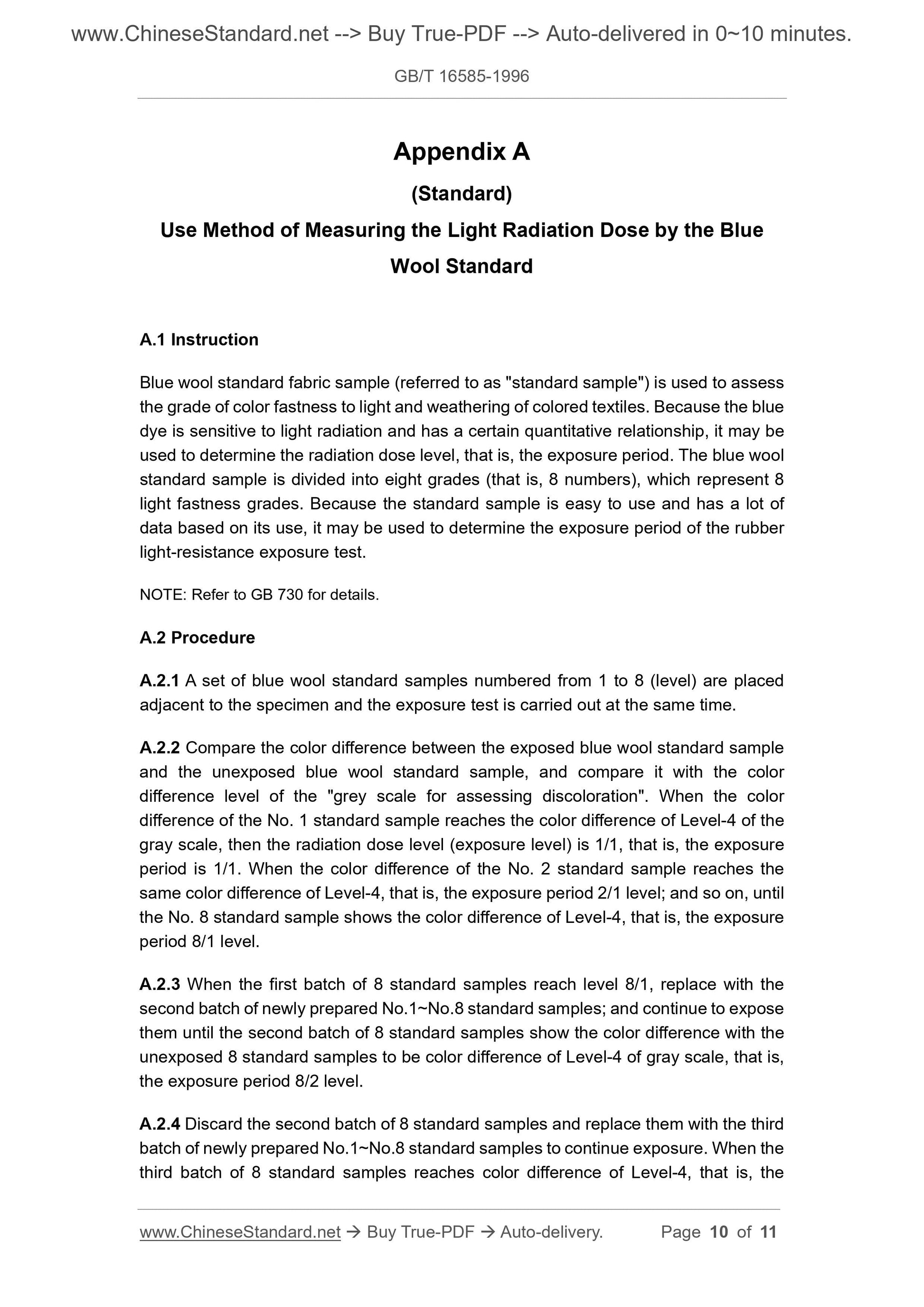1
/
of
6
PayPal, credit cards. Download editable-PDF and invoice in 1 second!
GB/T 16585-1996 English PDF (GBT16585-1996)
GB/T 16585-1996 English PDF (GBT16585-1996)
Regular price
$125.00 USD
Regular price
Sale price
$125.00 USD
Unit price
/
per
Shipping calculated at checkout.
Couldn't load pickup availability
Delivery: 3 seconds. Download true-PDF + Invoice.
Get QUOTATION in 1-minute: Click GB/T 16585-1996
Historical versions: GB/T 16585-1996
Preview True-PDF (Reload/Scroll if blank)
GB/T 16585-1996: Rubber, vulcanized. Test method of resistance to artificial weathering (Fluorescent UV lamp)
GB/T 16585-1996
GB
NATIONAL STANDARD OF THE
PEOPLE’S REPUBLIC OF CHINA
ICS 83.060
G 40
Rubber, Vulcanized – Test Method of Resistance to
Artificial Weathering (Fluorescent UV Lamp)
ISSUED ON: OCTOBER 28, 1996
IMPLEMENTED ON: JUNE 01, 1997
Issued by: State Bureau of Quality and Technical Supervision
Table of Contents
Foreword ... 3
1 Scope ... 4
2 Normative References ... 4
3 Method Summary ... 5
4 Test Device ... 5
5 Specimen ... 6
6 Test Conditions ... 6
7 Test Procedure ... 7
8 Test Results ... 8
9 Test Report ... 9
Appendix A (Standard) Use Method of Measuring the Light Radiation Dose by
the Blue Wool Standard ... 10
Rubber, Vulcanized – Test Method of Resistance to
Artificial Weathering (Fluorescent UV Lamp)
1 Scope
This Standard specifies an artificial weathering test method that uses fluorescent
ultraviolet lamps and condensing devices to simulate natural climate solar ultraviolet
light, temperature and condensed water and other aging factors.
This Standard is applicable to the weather resistance test of vulcanized rubber
exposed to alternating ultraviolet light and condensation.
2 Normative References
The following standards contain provisions which, through reference in this Standard,
constitute provisions of this Standard. At the time of publication, the editions indicated
are valid. All standards are subject to revision. The parties who are using this Standard
shall explore the possibility of using the latest version of the following standards.
GB 250-1984 Gray Scale for Assessing Change in Color (idt ISO 105-A02:1984)
GB/T 528-1992 Determination of Tensile Properties of Vulcanized Rubber and
Thermoplastic Rubber
GB 730-1986 Blue Wool Standards for Color Fastness to Light and Weathering
(idt ISO 105-B:1984)
GB 2941-1991 Standard Temperature, Humidity and Time for Environmental
Regulation and Testing of Rubber Samples (eqv ISO 471:1983 ISO 1826:1981)
GB/T 9865.1-1996 Rubber, Vulcanized or Thermoplastic-Preparation of Samples
and Test Pieces-Part 1: Physical Tests (idt ISO 4661-1:1986)
GB/T 12831-1991 Rubber, Vulcanized - Test Method of Resistance to Artificial
Weathering (Xenon Lamp) (neq ISO 4665-3:1987)
GB/T 14835-1993 Rubber, Vulcanized. Determination of Adhesion to, and
Corrosion of Metals (neq ISO 4665-2:1985)
4.4 Blackboard thermometer
The blackboard thermometer is composed of a black aluminum plate of
75mm×10mm×2.5 mm connected with a temperature sensor. It shall be in the range
of the exposure center so that it reflects the test temperature as much as possible.
4.5 Instruments and reference materials for measuring radiation
According to conditions and needs, a radiation meter or reference materials may be
used to measure the light energy received by the sample.
4.5.1 Radiation meter
Radiation meter includes integrated illuminance meter and radiometer.
4.5.2 Reference materials
The blue wool standard shall comply with the relevant provisions of GB 730; the
standard gray scale shall comply with the relevant provisions of GB 250.
5 Specimen
5.1 The specimen preparation shall be in accordance with the relevant provisions of
GB/T 9865.
5.2 The shape and specification of the specimen are determined according to the
requirements of the evaluation index and the corresponding test standard. Such as
testing the tensile properties of the specimen shall be in accordance with GB/T 528
regulations.
5.3 The number of specimens is determined according to the times of test items.
Generally, there are no less than 3 valid specimens each time for each test.
5.4 The specimen for measuring the color change shall be in accordance with the
provisions of 6.2 of GB/T 12831.
6 Test Conditions
6.1 The test cycle time is generally specified as 4h UV exposure followed by 4h
condensation. If necessary, use 8h UV light exposure followed by 4h condensation.
6.2 The UV exposure temperature is generally specified as (50±3) °C. According to the
characteristics of the material and the application environment, (60±3) °C or other
temperature may be selected.
6.3 The condensing temperature is generally specified as (50±3) °C.
6.4 During the UV exposure period, the equilibrium temperature of the hot air supply
test box shall be kept within ±3°C.
6.5 During the condensation exposure period, the equilibrium temperature of the hot
water in the selected water tank shall be kept within ±3°C.
6.6 The water supplied to the water tank may be distilled water, deionized water or
potable tap water.
6.7 The closest distance between the specimen surface and the lamp plane is 50mm
and parallel.
6.8 The irradiance in the wavelength range of 280~400nm received by the surface of
the specimen is usually no more than 50W/m2, and there shall be no radiation below
270nm.
6.9 In order to facilitate inspection and termination of the test, the exposure test time
is generally specified as a multiple of 24h, 7d or a multiple of 7d.
7 Test Procedure
7.1 Specimen installation
The specimen is mounted on the specimen holder in a free state, with the exposed
surface of the specimen facing the lamp. When the specimen is not filled with the
holder, fill the remaining space with blank plates to keep the test conditions in the
chamber stable. During the exposure period, the position of the specimen in the center
of the exposed area and the edge of the exposed area shall be changed regularly to
reduce uneven exposure.
7.2 Exposure test
Start the test chamber, adjust the specified test conditions; and record the exposure
starting time; and keep the specified test conditions constant throughout the exposure
period.
7.3 Determination of UV radiation
7.3.1 Measuring radiation dose by instrument
Regularly place an ultraviolet light integrated illuminometer or radiometer on the side
of the exposed specimen holder to directly measure the received ultraviolet radiation
dose.
Appendix A
(Standard)
Use Method of Measuring the Light Radiation Dose by the Blue
Wool Standard
A.1 Instruction
Blue wool standard fabric sample (referred to as "standard sample") is used to assess
the grade of color fastness to light and weathering of colored textiles. Because the blue
dye is sensitive to light radiation and has a certain quantitative relationship, it may be
used to determine the radiation dose level, that is, the exposure period. The blue wool
standard sample is divided into eight grades (that is, 8 numbers), which represent 8
light fastness grades. Because the standard sample is easy to use and has a lot of
data based on its use, it may be used to determine the exposure period of the rubber
light-resistance exposure test.
NOTE: Refer to GB 730 for details.
A.2 Procedure
A.2.1 A set of blue wool standard samples numbered from 1 to 8 (level) are placed
adjacent to the specimen and the exposure test is carried out at the same time.
A.2.2 Compare the color difference between the exposed blue wool standard sample
and the unexposed blue wool standard sample, and compare it with the color
difference level of the "grey scale for assessing discoloration". When the color
difference of the No. 1 standard sample reaches the color difference of Level-4 of the
gray scale, then the radiation dose level (exposure level) is 1/1, that is, the exposure
period is 1/1. When the color difference of the No. 2 standard sample reaches the
same color difference of Level-4, that is, the exposure p...
Get QUOTATION in 1-minute: Click GB/T 16585-1996
Historical versions: GB/T 16585-1996
Preview True-PDF (Reload/Scroll if blank)
GB/T 16585-1996: Rubber, vulcanized. Test method of resistance to artificial weathering (Fluorescent UV lamp)
GB/T 16585-1996
GB
NATIONAL STANDARD OF THE
PEOPLE’S REPUBLIC OF CHINA
ICS 83.060
G 40
Rubber, Vulcanized – Test Method of Resistance to
Artificial Weathering (Fluorescent UV Lamp)
ISSUED ON: OCTOBER 28, 1996
IMPLEMENTED ON: JUNE 01, 1997
Issued by: State Bureau of Quality and Technical Supervision
Table of Contents
Foreword ... 3
1 Scope ... 4
2 Normative References ... 4
3 Method Summary ... 5
4 Test Device ... 5
5 Specimen ... 6
6 Test Conditions ... 6
7 Test Procedure ... 7
8 Test Results ... 8
9 Test Report ... 9
Appendix A (Standard) Use Method of Measuring the Light Radiation Dose by
the Blue Wool Standard ... 10
Rubber, Vulcanized – Test Method of Resistance to
Artificial Weathering (Fluorescent UV Lamp)
1 Scope
This Standard specifies an artificial weathering test method that uses fluorescent
ultraviolet lamps and condensing devices to simulate natural climate solar ultraviolet
light, temperature and condensed water and other aging factors.
This Standard is applicable to the weather resistance test of vulcanized rubber
exposed to alternating ultraviolet light and condensation.
2 Normative References
The following standards contain provisions which, through reference in this Standard,
constitute provisions of this Standard. At the time of publication, the editions indicated
are valid. All standards are subject to revision. The parties who are using this Standard
shall explore the possibility of using the latest version of the following standards.
GB 250-1984 Gray Scale for Assessing Change in Color (idt ISO 105-A02:1984)
GB/T 528-1992 Determination of Tensile Properties of Vulcanized Rubber and
Thermoplastic Rubber
GB 730-1986 Blue Wool Standards for Color Fastness to Light and Weathering
(idt ISO 105-B:1984)
GB 2941-1991 Standard Temperature, Humidity and Time for Environmental
Regulation and Testing of Rubber Samples (eqv ISO 471:1983 ISO 1826:1981)
GB/T 9865.1-1996 Rubber, Vulcanized or Thermoplastic-Preparation of Samples
and Test Pieces-Part 1: Physical Tests (idt ISO 4661-1:1986)
GB/T 12831-1991 Rubber, Vulcanized - Test Method of Resistance to Artificial
Weathering (Xenon Lamp) (neq ISO 4665-3:1987)
GB/T 14835-1993 Rubber, Vulcanized. Determination of Adhesion to, and
Corrosion of Metals (neq ISO 4665-2:1985)
4.4 Blackboard thermometer
The blackboard thermometer is composed of a black aluminum plate of
75mm×10mm×2.5 mm connected with a temperature sensor. It shall be in the range
of the exposure center so that it reflects the test temperature as much as possible.
4.5 Instruments and reference materials for measuring radiation
According to conditions and needs, a radiation meter or reference materials may be
used to measure the light energy received by the sample.
4.5.1 Radiation meter
Radiation meter includes integrated illuminance meter and radiometer.
4.5.2 Reference materials
The blue wool standard shall comply with the relevant provisions of GB 730; the
standard gray scale shall comply with the relevant provisions of GB 250.
5 Specimen
5.1 The specimen preparation shall be in accordance with the relevant provisions of
GB/T 9865.
5.2 The shape and specification of the specimen are determined according to the
requirements of the evaluation index and the corresponding test standard. Such as
testing the tensile properties of the specimen shall be in accordance with GB/T 528
regulations.
5.3 The number of specimens is determined according to the times of test items.
Generally, there are no less than 3 valid specimens each time for each test.
5.4 The specimen for measuring the color change shall be in accordance with the
provisions of 6.2 of GB/T 12831.
6 Test Conditions
6.1 The test cycle time is generally specified as 4h UV exposure followed by 4h
condensation. If necessary, use 8h UV light exposure followed by 4h condensation.
6.2 The UV exposure temperature is generally specified as (50±3) °C. According to the
characteristics of the material and the application environment, (60±3) °C or other
temperature may be selected.
6.3 The condensing temperature is generally specified as (50±3) °C.
6.4 During the UV exposure period, the equilibrium temperature of the hot air supply
test box shall be kept within ±3°C.
6.5 During the condensation exposure period, the equilibrium temperature of the hot
water in the selected water tank shall be kept within ±3°C.
6.6 The water supplied to the water tank may be distilled water, deionized water or
potable tap water.
6.7 The closest distance between the specimen surface and the lamp plane is 50mm
and parallel.
6.8 The irradiance in the wavelength range of 280~400nm received by the surface of
the specimen is usually no more than 50W/m2, and there shall be no radiation below
270nm.
6.9 In order to facilitate inspection and termination of the test, the exposure test time
is generally specified as a multiple of 24h, 7d or a multiple of 7d.
7 Test Procedure
7.1 Specimen installation
The specimen is mounted on the specimen holder in a free state, with the exposed
surface of the specimen facing the lamp. When the specimen is not filled with the
holder, fill the remaining space with blank plates to keep the test conditions in the
chamber stable. During the exposure period, the position of the specimen in the center
of the exposed area and the edge of the exposed area shall be changed regularly to
reduce uneven exposure.
7.2 Exposure test
Start the test chamber, adjust the specified test conditions; and record the exposure
starting time; and keep the specified test conditions constant throughout the exposure
period.
7.3 Determination of UV radiation
7.3.1 Measuring radiation dose by instrument
Regularly place an ultraviolet light integrated illuminometer or radiometer on the side
of the exposed specimen holder to directly measure the received ultraviolet radiation
dose.
Appendix A
(Standard)
Use Method of Measuring the Light Radiation Dose by the Blue
Wool Standard
A.1 Instruction
Blue wool standard fabric sample (referred to as "standard sample") is used to assess
the grade of color fastness to light and weathering of colored textiles. Because the blue
dye is sensitive to light radiation and has a certain quantitative relationship, it may be
used to determine the radiation dose level, that is, the exposure period. The blue wool
standard sample is divided into eight grades (that is, 8 numbers), which represent 8
light fastness grades. Because the standard sample is easy to use and has a lot of
data based on its use, it may be used to determine the exposure period of the rubber
light-resistance exposure test.
NOTE: Refer to GB 730 for details.
A.2 Procedure
A.2.1 A set of blue wool standard samples numbered from 1 to 8 (level) are placed
adjacent to the specimen and the exposure test is carried out at the same time.
A.2.2 Compare the color difference between the exposed blue wool standard sample
and the unexposed blue wool standard sample, and compare it with the color
difference level of the "grey scale for assessing discoloration". When the color
difference of the No. 1 standard sample reaches the color difference of Level-4 of the
gray scale, then the radiation dose level (exposure level) is 1/1, that is, the exposure
period is 1/1. When the color difference of the No. 2 standard sample reaches the
same color difference of Level-4, that is, the exposure p...
Share
